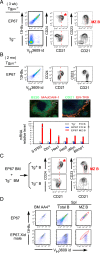Natural anti-intestinal goblet cell autoantibody production from marginal zone B cells
- PMID: 25480561
- PMCID: PMC4282382
- DOI: 10.4049/jimmunol.1402383
Natural anti-intestinal goblet cell autoantibody production from marginal zone B cells
Abstract
Expression of a germline VH3609/D/JH2 IgH in mice results in the generation of B1 B cells with anti-thymocyte/Thy-1 glycoprotein autoreactivity by coexpression of Vk21-5/Jk2 L chain leading to production of serum IgM natural autoantibody. In these same mice, the marginal zone (MZ) B cell subset in spleen shows biased usage of a set of Ig L chains different from B1 B cells, with 30% having an identical Vk19-17/Jk1 L chain rearrangement. This VH3609/Vk19-17 IgM is reactive with intestinal goblet cell granules, binding to the intact large polymatrix form of mucin 2 glycoprotein secreted by goblet cells. Analysis of a μκ B cell AgR (BCR) transgenic (Tg) mouse with this anti-goblet cell/mucin2 autoreactive (AGcA) specificity demonstrates that immature B cells expressing the Tg BCR become MZ B cells in spleen by T cell-independent BCR signaling. These Tg B cells produce AGcA as the predominant serum IgM, but without enteropathy. Without the transgene, AGcA autoreactivity is low but detectable in the serum of BALB/c and C.B17 mice, and this autoantibody is specifically produced by the MZ B cell subset. Thus, our findings reveal that AGcA is a natural autoantibody associated with MZ B cells.
Copyright © 2015 by The American Association of Immunologists, Inc.
Figures






References
-
- Boyden S. V. 1966. Natural antibodies and the immune response. Adv. Immunol. 5: 1–28. - PubMed
-
- Avrameas S. 1991. Natural autoantibodies: from ‘horror autotoxicus’ to ‘gnothi seauton’. Immunol. Today 12: 154–159. - PubMed
-
- Coutinho A., Kazatchkine M. D., Avrameas S. 1995. Natural autoantibodies. Curr. Opin. Immunol. 7: 812–818. - PubMed
-
- Ehrenstein M. R., Notley C. A. 2010. The importance of natural IgM: scavenger, protector and regulator. Nat. Rev. Immunol. 10: 778–786. - PubMed
Publication types
MeSH terms
Substances
Grants and funding
LinkOut - more resources
Full Text Sources
Other Literature Sources
Molecular Biology Databases
Miscellaneous

